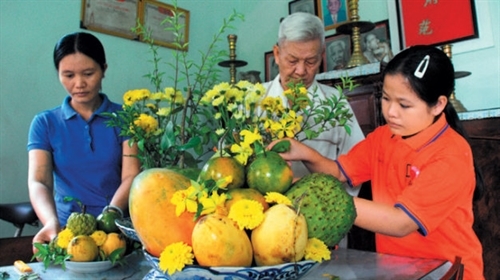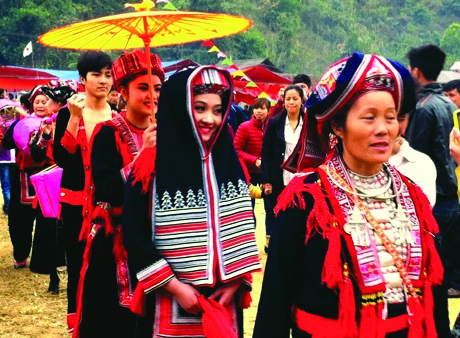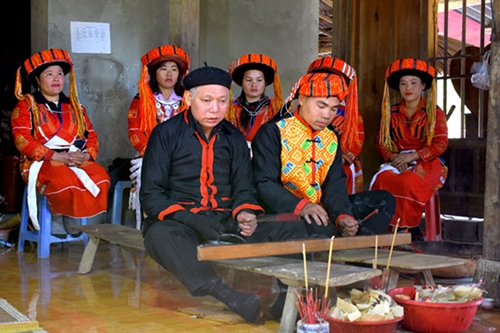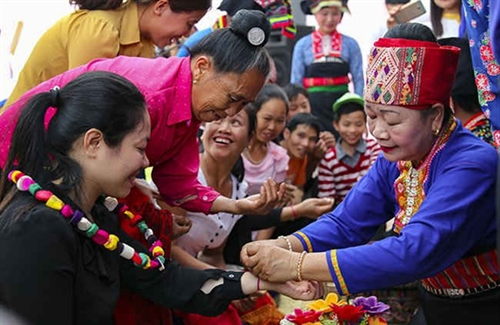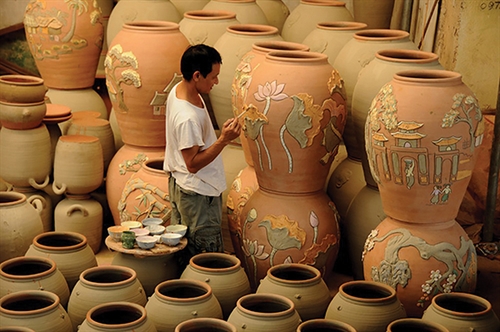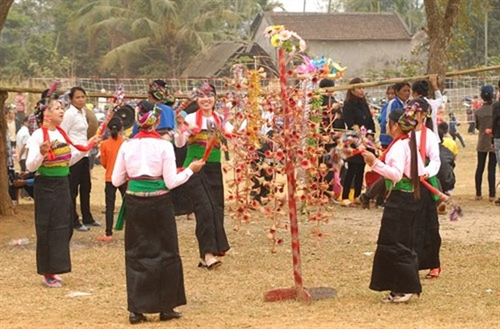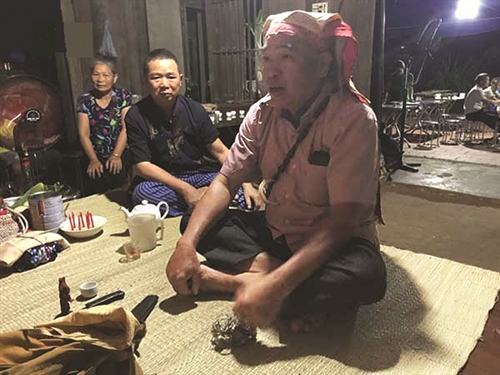Spring in Vietnam begins with the traditional Tet which has been for thousands of years now celebrated on the first day of the first month of the Lunar Year, the ancient agricultural calendar observed by most Asian countries.
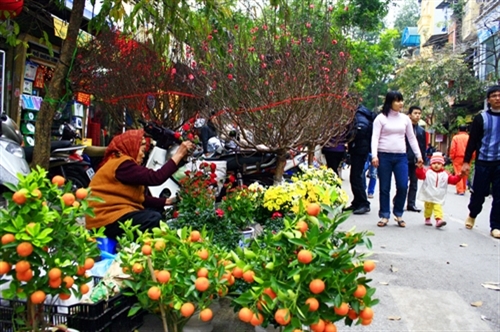 |
| A Tet traditional flower market in Hanoi__Photo: Internet |
For the Vietnamese, wherever they may be, in the country or abroad, Tet is a very special, very sacred occasion for them to remember their ancestors and all their deceased dear ones, and to long for family reunion, an occasion for extending to one another the best wishes for the New Year, for games and parties, and community entertainment at traditional festivals in the villages. That is why, preparations for the Tet are always busy and assume a visible sense or urgency in the last ten days of the Lunar Year, after the flower and fruit markets and the shops selling Tet pictures and firecrackers and other necessities for the occasion have opened. That is also the time when, in the immense countryside and the mountain areas, the “cay neu”, the traditional luckbearing bamboo pole, is erected in the frontyard, on the courtyard of the communal house, beside the waterwheel or the family ricehusking mill. All the market places, in town and countryside alike, become unusually crowded from dawn to dusk. Some markets are held until the last hour of the last days of the Lunar Year and even throughout the night as is the case of the Gia Lac market in Hue, the former imperial city. All the houses are given a thorough clean-up and decorated with ornamental red paper parallel scrolls written with Vietnamese or Chinese wishes for the New Year. The ancestral altar is decorated with folk paintings and cuttings of apricot or beach blossoms or at least a bouquet of flowers beside a tray of the traditional “five fruit” offering.
The evening of the 30th day of the 12th lunar month is always one of the most sacred moment in the year. As the clock points to zero hour of the New Year, firecrackers burst in all homes almost simultaneously(1), the bells chime at all pagodas and churches. Over the radio and on the television, the State President extends his New Year wishes to all Vietnamese in the country and overseas. The first day and following days are the time for the popular festivals which are held according to the customs and habits of each locality and each ethnic group, but always at the idle time of field work.
For all ethnic groups in the country, the first days of the New Year are devoted to mutual visits. In many localities and among many ethnic groups, the housewarming custom still is preserved. The first visitor in the New Year is expected to bring with him or her the best luck to the family in the whole year. Host and guest exchange wishes for good health, happiness and thriving business. The Kinh (or Viet) invite their guests to a betel chew, a cup of tea or a glass of rice wine and an assortment of comfits, including the indispensable grilled melon or sunflower seeds. Also indispensable among the Muong, Thai in the Northwest and the ethnic minorities in the Central Highlands is the drinking of rice wine sucked with straws made of hollowed out stalks.
The Tet is also the occasion for the most elaborate and most copious, and also most long drawn-out reveling and feasting. There are some indispensable dishes of the national cuisine, notably spring rolls, boiled and stewed chicken, and more particularly, packed frozen pork to go with onion pickles. Even more popular is the “banh chung” and “banh tet”, both made of glutious rice and almost the same condiments, but named differently because of their shapes, the one being square and the other cylindrical. These two kinds of cake are believed to be devised by a son of the Hung king at the dawn of the nation’s history who abdicated in his favor after eating these cakes offered him by the prince on the occasion of the Lunar New Year.
In the mountainous regions, people of ethnic minorities prefer the “banh day” during the Tet. This is basically a mass of pounded glutinous rice to be eaten with pork, chicken and any other salted food. The people’s longing for the return of spring is conveyed by the leaf wrapping of the “banh day” cut in the form of the tail of a swallow.
But Tet does not simply mean mutual visits and wishes and feasting. This is also the occasion for all villages and communities to attend festivals, both traditional and modern. In the old Hanoi, the population would gather around the firecracker exploding game which consisted in the ignition of various kinds of crackers which were very ingeniously designed to imitate the movement of a mouse, a cat or a duck. Vietnam also has its own primitive form of firework which combines the techniques of other firecrackers. Among the traditional games, the most popular are wrestling which may date back to the first century of our era, martial arts, Chinese chess, cock fighting, bird fighting, swinging, etc. In some parts of the mountain areas, horse race and bow shooting are still practiced. In recent years, more and more modern games have been introduced, such as circus, trapeze, magic, sport competitions, music performances, theater, poem recitals, etc. In the Red River delta, this is the time for the popular song and drama festivals, or competitions held within one village or between several villages. On the morning of the New Year Day, at Gia Lac market place in Hue city, a very original card game called “mirador card game” is held, with each player and his assistants seating on a high mirador erected at one corner of the market. Each pass is called out by a herald (now replaced by a microphone). The game is intercalated with songs and music performances which create a very jubilant atmosphere over a large area.
Further to the South, the Tet is the occasion for the demonstration of very long standing martial arts, especially in Binh Dinh province. In the Central Highlands, it is the season for the best crossbow shooters to exhibit their skill before the admiring eyes of their lovers. The greatest challenge is to shoot an arrow at a knife blade planted about thirty metres away so that the arrow is split in two by the blade. For the M’Nong in Ban Don which has the largest elephant population in Vietnam, the elephant race is organized only once in a year during the Spring Festival. For the Xo Dang people, also in the Central Highlands, they are most interested in the demonstration of martial arts, while the young women of the Gia Rai ethnic minority vie with one another in the belly dance called “roong chieng” (dance around a wine jar).
In the old days, several festivals of a ritual or religious character were held in nearly all parts of the country. Most frequently seen were the “prayer for rain” or the ceremony to descend into the field, at which an old man, usually the oldest and most respected in the commune, would make a few symbolical strokes of the hoe into the field to announce the start of a new farming year. These festivals which are said to date back to the Ly dynasty (1009-1225) were still observed in Hanoi in the middle of the 18th century. Today, Hanoi still retains most of the significant festivals of the population and has adopted new and meaningful customs, such as visit to the Mausoleum of President Ho Chi Minh, or organizing an Arbor Day in all parts of the capital’s suburban villages, or masquerades impersonating persons of different traditional crafts in the capital city.- (VLLF)
